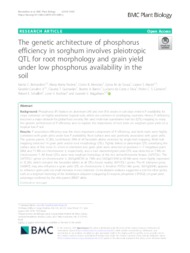The genetic architecture of phosphorus efficiency in sorghum involves pleiotropic QTL for root morphology and grain yield under low phosphorus availability in the soil.
The genetic architecture of phosphorus efficiency in sorghum involves pleiotropic QTL for root morphology and grain yield under low phosphorus availability in the soil.
Autoria: BERNARDINO, K. C.; PASTINA, M. M.; MENEZES, C. B. de; SOUSA, S. M. de; MACIEL, L. S.; CARVALHO JÚNIOR, G.; GUIMARÃES, C. T.; BARROS, B. de A.; SILVA, L. da C. e; CARNEIRO, P. C. S.; SCHAFFERT, R. E.; KOCHIAN, L. V.; MAGALHAES, J. V. de
Resumo: Background: Phosphorus (P) fixation on aluminum (Al) and iron (Fe) oxides in soil clays restricts P availability for crops cultivated on highly weathered tropical soils, which are common in developing countries. Hence, P deficiency becomes a major obstacle for global food security. We used multi-trait quantitative trait loci (QTL) mapping to study the genetic architecture of P efficiency and to explore the importance of root traits on sorghum grain yield on a tropical low-P soil. Results: P acquisition efficiency was the most important component of P efficiency, and both traits were highly correlated with grain yield under low P availability. Root surface area was positively associated with grain yield. The guinea parent, SC283, contributed 58% of all favorable alleles detected by single-trait mapping. Multi-trait mapping detected 14 grain yield and/or root morphology QTLs. Tightly linked or pleiotropic QTL underlying the surface area of fine roots (1?2?mm in diameter) and grain yield were detected at positions 1?7 megabase pairs (Mb) and 71?Mb on chromosome 3, respectively, and a root diameter/grain yield QTL was detected at 7?Mb on chromosome 7. All these QTLs were near sorghum homologs of the rice serine/threonine kinase, OsPSTOL1. The SbPSTOL1 genes on chromosome 3, Sb03g006765 at 7?Mb and Sb03g031690 at 60?Mb were more highly expressed in SC283, which donated the favorable alleles at all QTLs found nearby SbPSTOL1 genes. The Al tolerance gene, SbMATE, may also influence a grain yield QTL on chromosome 3. Another PSTOL1-like gene, Sb07g02840, appears to enhance grain yield via small increases in root diameter. Co-localization analyses suggested a role for other genes, such as a sorghum homolog of the Arabidopsis ubiquitin-conjugating E2 enzyme, phosphate 2 (PHO2), on grain yield advantage conferred by the elite parent, BR007 allele. Conclusions: Genetic determinants conferring higher root surface area and slight increases in fine root diameter may favor P uptake, thereby enhancing grain yield under low-P availability in the soil. Molecular markers for SbPSTOL1 genes and for QTL increasing grain yield by non-root morphology-based mechanisms hold promise in breeding strategies aimed at developing sorghum cultivars adapted to low-P soils.
Ano de publicação: 2019
Tipo de publicação: Artigo de periódico
Unidade: Embrapa Milho e Sorgo
Palavras-chave: Deficiência, Fósforo, Raiz, Solo Ácido, Sorgo
Observações
1 - Por padrão são exibidas publicações dos últimos 20 anos. Para encontrar publicações mais antigas, configure o filtro ano de publicação, colocando o ano a partir do qual você deseja encontrar publicações. O filtro está na coluna da esquerda na busca acima.
2 - Para ler algumas publicações da Embrapa (apenas as que estão em formato ePub), é necessário ter, no celular ou computador, um desses softwares gratuitos. Sistemas Android: Google Play Livros; IOS: iBooks; Windows e Linux: software Calibre.
Acesse outras publicações
Acesse a Base de Dados da Pesquisa Agropecuária (BDPA) para consultar o acervo completo das bibliotecas da Embrapa.

